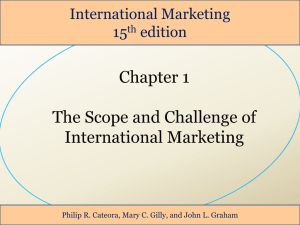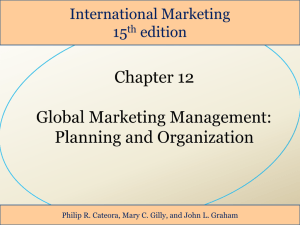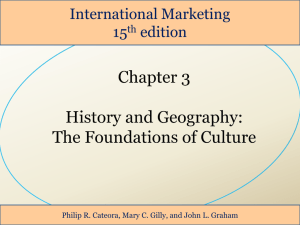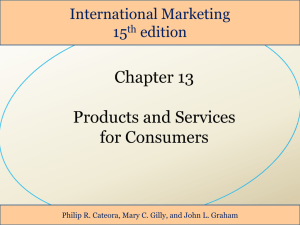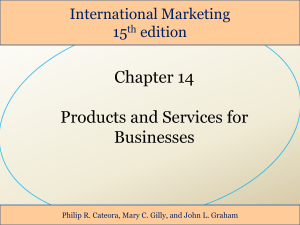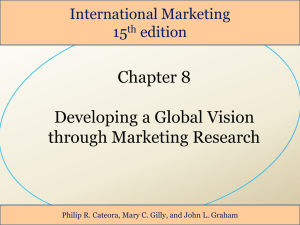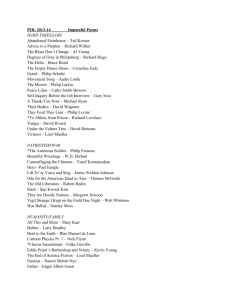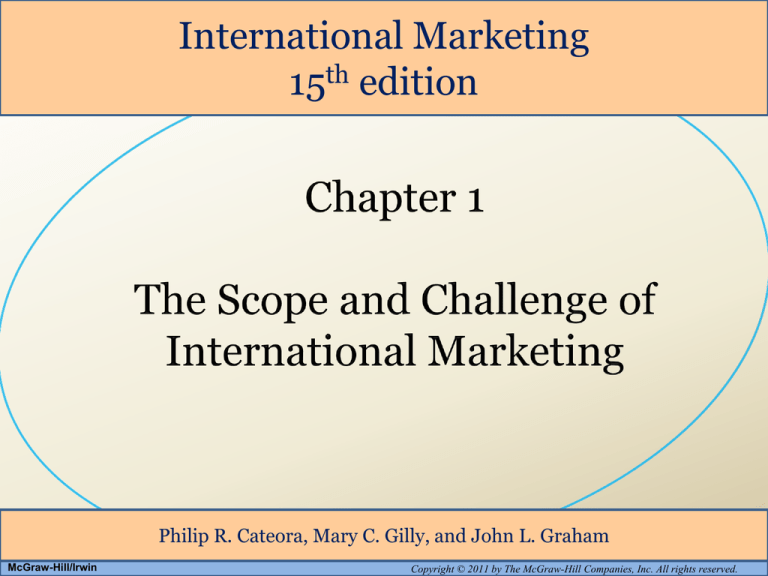
International Marketing
15th edition
Philip R. Cateora, Mary C. Gilly, and John L. Graham
McGraw-Hill/Irwin
Copyright © 2011 by The McGraw-Hill Companies, Inc. All rights reserved.
Introduction (1 of 2)
1
• Major events at the turn of the century:
–
–
–
–
–
–
–
The technological bubble bust of 2001
Terrorism on 9/11
The Afghanistan and Iraq wars
The 2003 SARS outbreak in Asia
The Indian ocean Tsunami in December 2004
Price of oil at $100 a barrel
NASA budget cuts threaten the demise of the
space shuttle program
Roy Philip
2
Introduction (2 of 2)
1
• Consumer spending rose despite the layoffs at
United Airlines and Boeing and the tough job
market
• The housing bubble burst during the end of
2008 and the American consumer stopped
buying causing a 12 percent drop, the deepest
decline in world trade in 50 years!
• International trade tensions are rising from
competitors in China, Brazil and India
• The U.S. trade deficit keeps rising ($14 trillion)
Roy Philip
3
Overview of Chapter 1
•
•
•
•
•
•
•
•
•
1
What is International Marketing?
Benefits of International Marketing
Globalization of U.S. corporations
International marketing task
Imperativeness of Environmental Adaptation
Self-reference criterion and Ethnocentrism
Developing a global mindset
Stages of international marketing involvement
The orientation of international marketing
Roy Philip
4
Global Perspective
1
Global Commerce Causes Peace
•
•
•
The role of world trade and international
marketing in producing peace
International marketing promotes peace and
prosperity through the marketing of products
and services that meet the needs and wants of
customers in other lands
Two examples
–
–
Large Multinational – Boeing
Small Multinational - PeaceWorks
Roy Philip
5
Events and Trends
Affecting Global Business
•
•
•
•
1
The rapid growth of the World Trade
Organization (WTO) and NAFTA and EU
The trend toward the acceptance of the free
market system among developing countries in
Latin America, Asia, and Eastern Europe
The burgeoning impact of the Internet, mobile
phones, and other global media on the
dissolution of national borders
The mandate to properly manage the resources
and global environment for the generations to
come
Roy Philip
6
Internationalization of
U.S. Business (1 of 2)
•
The world is one market – increasing
globalization of markets
–
•
1
Sony, Norelco, Samsung, Honda, Toyota,
Nescafe
Many U.S. companies are foreign controlled
–
–
–
–
–
7-Eleven and Firestone – Japan
Carnation – Switzerland
Wall Street Journal – Australia
Smith & Wesson – Britain
Zenith – South Korea (LG Electronics)
Roy Philip
7
Foreign Acquisitions
of U.S. Companies
1
Exhibit 1.1
Roy Philip
8
Internationalization of
U.S. Business (2 of 2)
•
•
•
1
Foreign companies are here to stay in the U.S.
and compete with U. S. companies
The great worldwide acquisitions both by U. S.
and foreign companies
Global markets are a necessity
–
–
–
–
Foreign earnings a higher percentage of profits
Multinationals outperform domestic firms
Global value increased through global
diversification
Intensifying domestic competition
Roy Philip
9
Selected U.S. Companies 1
and Their International Sales
Exhibit 1.2
Roy Philip
10
International Marketing
•
•
1
International marketing is defined as the
performance of business activities designed to
plan, price, promote, and direct the flow
of a company’s goods and services to
consumers or users in more than one nations
for a profit.
The difference is the “environment”
–
Competition, legal restraints, government controls,
weather, fickle consumers, economic conditions,
technological constraints, infrastructure concerns,
culture, and political situations.
Roy Philip
11
The International Marketing Task
1
Exhibit 1.3
Roy Philip
12
The International Marketing Task
Marketing Decision
• Firm
Characteristics
• Product
• Price
• Place
• Promotion
• Research
Domestic Environment
•
•
•
•
Political forces
Legal forces
Economic forces
Competition
Roy Philip
1
Foreign Environment
•
•
•
•
•
Political forces
Legal forces
Economic forces
Competition
Level of
technology
• Geography
• Culture
13
Environmental Adaptation
•
•
The most challenging and important adaptation
international marketers must make is cultural
adjustments.
Must establish a frame of reference
–
–
•
1
Time-conscious Americans vs. Time-is-not-anasset thinking Latin Americans
Hand gestures vary between countries
“Cultural Conditioning” – be aware of home
cultural references before making decisions
Roy Philip
14
Obstacles to Adaptation
•
•
1
Adaptation is a conscious effort on the part of
the international marketer to anticipate the
influences of both the foreign and domestic
uncontrollable factors on a marketing mix and
then to adjust the marketing mix to minimize
the effects.
Two primary obstacles are:
–
–
Self-Reference Criterion (SRC)
Ethnocentrism
Roy Philip
15
Self-Reference Criterion
(SRC)
•
•
1
Self-Reference Criterion (SRC) is an
unconscious reference to one’s own cultural
values, experiences, and knowledge as a basis
for decision.
Risk of SRC:
–
–
Prevent you from becoming aware of cultural
differences
Influence the evaluation of the appropriateness
of a domestically designed marketing mix for a
foreign market
Roy Philip
16
Ethnocentrism
•
•
1
The notion that people in one’s own company,
culture, or country know best how to do things.
Risk of Ethnocentrism:
–
Impedes the ability to assess a foreign market in
its true light
Roy Philip
17
Beyond Obstacles
to Adaptation
•
1
The most effective way to control the influence
of SRC and Ethnocentrism is:
–
–
–
To recognize the effects on our behavior
To recognize that there may be more similarities
than differences between countries
To conduct cross-cultural analysis
Roy Philip
18
Cross-Cultural Analysis
1
1. Define business problem or goal in homecountry cultural traits, habits, or norms
2. Define business problem or goal in foreigncountry cultural traits, habits, or norms
through consultation with natives of target
country
3. Isolate the SRC influence and examine it
carefully to see how it complicates the problem
4. Redefine the problem without SRC influence
and solve for the optimum business goal
situation
Roy Philip
19
Developing
Global Awareness
•
Tolerance of cultural differences
–
•
1
You do not have to accept as your own the
cultural ways of another, but you must allow
others to be different and equal
Knowledge of cultures, history, world market
potential, and global economic, social, and
political trends
Roy Philip
20
Approaches to
Global Awareness
•
•
•
1
Select individual managers that express a
global awareness orientation
Develop personal relationships in foreign
countries
Must have the support of a culturally diverse
senior executive staff or board of directors
Roy Philip
21
International Marketing
Involvement - Stages
1
No Direct
Infrequent Foreign
Foreign Marketing
Marketing
Global
Marketing
Regular Foreign
International
Marketing
Marketing
Roy Philip
22
No Direct Foreign
Marketing – Reactive
•
Products “indirectly” reach foreign markets
•
•
•
•
•
1
Trading companies
Foreign customers who contact firm
Domestic wholesalers/distributors
Web orders
Foreign orders stimulate a company’s interest
to seek additional international sales
Roy Philip
23
Infrequent Foreign
Marketing – Reactive
•
Caused by temporary surpluses
–
•
1
Sales to foreign markets are made as goods
become available
Firm has little or no intention of maintaining
continuous market representation
• Foreign sales activity declines and is
withdrawn when domestic demand increases
Roy Philip
24
Regular Foreign
Marketing – Proactive
1
• Dedicated production capacity for foreign
markets
• Strategy:
– Firm employs domestic or foreign intermediaries
– Uses its own sales force or sales subsidiaries
• Products are adapted for foreign markets as
domestic demand grows
• Firms depend on profits from foreign markets
Roy Philip
25
International Marketing –
Proactive
1
• Fully committed and involved in foreign markets
and international activities
• Production takes place on foreign soil earning
firms the MNC (Multinational Corporation) title
• Fedders being “proactive:”
– Looked to Asia for future growth after stymied
U.S. sales
– Designed new types of air conditioner unit for the
Chinese market
– Plan to introduce new product in the U.S!
Roy Philip
26
Global Marketing –
Proactive
1
• The firm sees the world as one market!
• Market segmentation is now defined by income
levels, usage patterns, or other factors that span
the globe
• More than half of its revenues come from abroad
• The firm has a global perspective
Roy Philip
27
Global Market Orientation
1
• This orientation entails operating as if all the
country markets in a company’s scope of operations
(including the domestic market) were approachable
as a single global market and standardizing the
marketing mix where culturally feasible and cost
effective.
• Depending on the product and market, firms may
pursue a global market strategy for one product
(global market orientation – P&G diapers) but a
multidomestic strategy for another product
(international market orientation = P&G
detergents).
Roy Philip
28
Textbook’s Orientation
1
• An environmental/cultural approach to
international strategic marketing
• Aim is to demonstrate the unique problems of
international marketing
• Attempts to relate the foreign environment to
the marketing process and to illustrate the many
ways in which culture can influence the
marketing task
Roy Philip
29
Foreign Policy’s Global Top 20
1
Exhibit 1.4
Roy Philip
30
Summary (1 of 2)
1
• It is imperative for firms to pay attention to the
global environment in the wake of intense
globalization of markets and competition.
• The difference between domestic marketing and
international marketing is the environment that
consist of laws, customs, and cultural
differences.
• Key obstacles to successful international
marketing are self-reference criterion (SRC) and
Ethnocentrism
Roy Philip
31
Summary (2 of 2)
1
• Global awareness and sensitivity are solutions to
the obstacles of SRC and ethnocentrism
• Five different international marketing
involvement strategies were discussed: No direct
foreign marketing, infrequent foreign marketing,
regular foreign marketing, international
marketing, and global marketing
• Firms must have global orientation – the world
is seen as one market
Roy Philip
32

